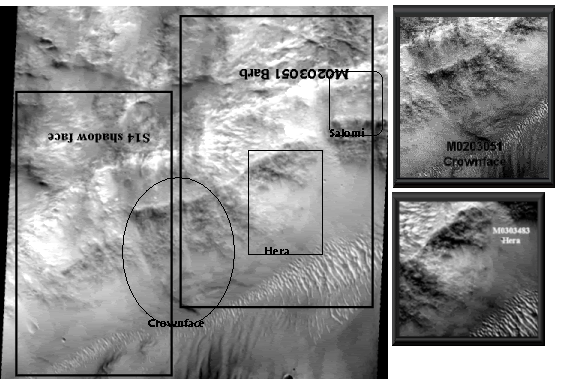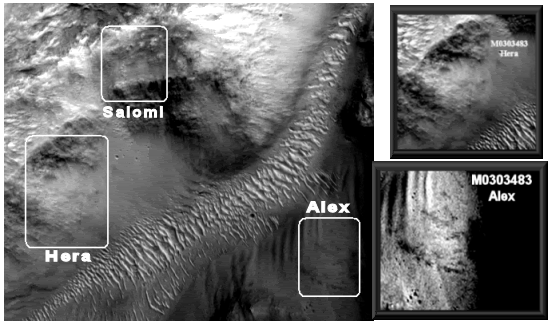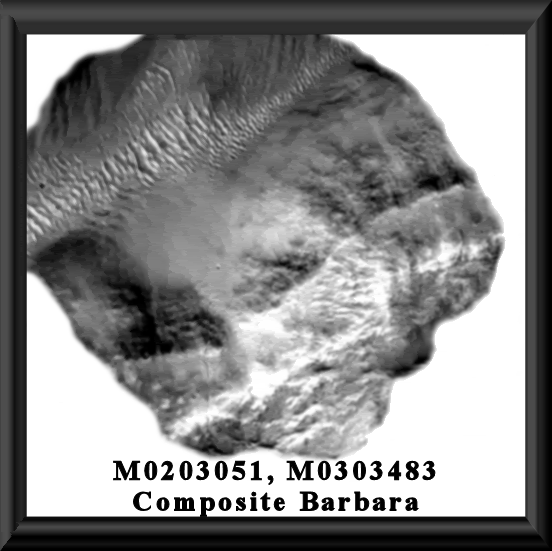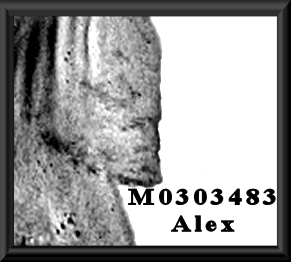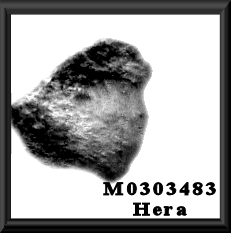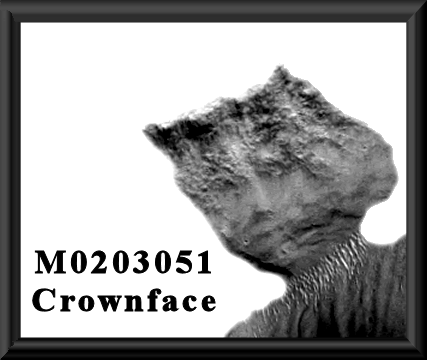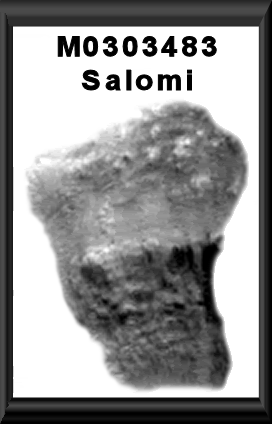- Thank you received: 0
Faces from the Chasmas
- neilderosa
-
- Offline
- Platinum Member
-

Less
More
18 years 1 month ago #16529
by neilderosa
Replied by neilderosa on topic Reply from Neil DeRosa
<blockquote id="quote"><font size="2" face="Verdana, Arial, Helvetica" id="quote">quote:<hr height="1" noshade id="quote">The right eye of your Barbara must also be an inverted Crownface![rd]<hr height="1" noshade id="quote"></blockquote id="quote"></font id="quote">
Maybe (previous images NS inverted).
Maybe (previous images NS inverted).
Please Log in or Create an account to join the conversation.
- neilderosa
-
- Offline
- Platinum Member
-

Less
More
- Thank you received: 0
18 years 1 month ago #16530
by neilderosa
Replied by neilderosa on topic Reply from Neil DeRosa
<blockquote id="quote"><font size="2" face="Verdana, Arial, Helvetica" id="quote">quote:<hr height="1" noshade id="quote">In short Barbara got Skullfaced by this image swath.[rd's "paradoolia" thread]<hr height="1" noshade id="quote"></blockquote id="quote"></font id="quote">
In a sense this part is still true. Just as JP's public request image for a confirmation of Skullface was taken off-center, missing a good opportunity to re-image an object of interest in its best possible light—In this case that probably happened to Crownface, with public request image S14 missing that famous face totally but picking up instead a “shadow” of Barbara. Maybe the image manager thought he would thereby show Barbara in the worst possible light, as I at first thought had happened.
In a way it <i>was</i> “Sullfaced.” I have seen this happen other times before; it has happened numerous times of course to the Cydonia face, and twice to Nefertiti. But the verb concept (to Skullface) is not “metaphysical;” it is instead “man-made,” (by whichever NASA contractor) if you remember your Ayn Rand aphorisms. Maybe I’ll start designating my new concept (of a man-made, missed opportunity for an excellent conformation of an artificial object, by means of an out of focus or out of whack re-imaging job) as “to Crownface.”
In a sense this part is still true. Just as JP's public request image for a confirmation of Skullface was taken off-center, missing a good opportunity to re-image an object of interest in its best possible light—In this case that probably happened to Crownface, with public request image S14 missing that famous face totally but picking up instead a “shadow” of Barbara. Maybe the image manager thought he would thereby show Barbara in the worst possible light, as I at first thought had happened.
In a way it <i>was</i> “Sullfaced.” I have seen this happen other times before; it has happened numerous times of course to the Cydonia face, and twice to Nefertiti. But the verb concept (to Skullface) is not “metaphysical;” it is instead “man-made,” (by whichever NASA contractor) if you remember your Ayn Rand aphorisms. Maybe I’ll start designating my new concept (of a man-made, missed opportunity for an excellent conformation of an artificial object, by means of an out of focus or out of whack re-imaging job) as “to Crownface.”
Please Log in or Create an account to join the conversation.
- neilderosa
-
- Offline
- Platinum Member
-

Less
More
- Thank you received: 0
18 years 1 month ago #16552
by neilderosa
Replied by neilderosa on topic Reply from Neil DeRosa
<blockquote id="quote"><font size="2" face="Verdana, Arial, Helvetica" id="quote">quote:<hr height="1" noshade id="quote">By concentrating scientific attention upon a narrow area of trouble and by preparing the scientific mind to recognize experimental anomalies for what they are, crises often proliferates new discoveries. [Thomas Kuhn, <i>The</i> <i>Structure of Scientific Revolutions</i>, 88] <hr height="1" noshade id="quote"></blockquote id="quote"></font id="quote">
Please Log in or Create an account to join the conversation.
18 years 1 month ago #16553
by rderosa
Replied by rderosa on topic Reply from Richard DeRosa
I'll tell you one thing. Here's one heck of a possible <i>a priori </i>prediction. If there's a nose, mouth and rest of the face revealed for this second Crownface in the upper right hand corner in subsequent imaging, I might have to convert. For them both to be eyes of inverted Barbaras would be too much even for me to deny. In this image (cropped from M0203051) you can see the hint of the eyes and top of the nose bridge, but that's about it.
From M0303483
Added Note #1: After re-reading Greg Orme's "The Kingface Valley" I realized that the bottom half of the last image is most likely sand, so that newer and better imaging is not likely to show much more. He speculates on another Crownface on the other side (our left when viewed rightside up) that might also be buried in sand and just leaving the crown exposed. In this image posted here, Orme talks about two small faces in the crown, but doesn't mention the possibility of this being yet another Crownface. Also, I've seen no mention of Neil's macro faces (Barbara and Shadow Barb) facing in the opposite NS direction, in which Crownfaces are the eyes.
Added Note #2: At the end of "The Kingface Valley" Greg Orme makes this statement:
<blockquote id="quote"><font size="2" face="Verdana, Arial, Helvetica" id="quote">quote:<hr height="1" noshade id="quote">Until we actually visit Mars and drive into the King’s Valley we can never know for sure. All we can do is examine the photos and make up our own minds. The probabilities mentioned if accurate prove that these formations must be either artificial or have formed by some kind of common factor, but the methodology could also be flawed in some way. As a guide though it does indicate the King’s Valley is one of the most unusual places on Mars. G. Orme<hr height="1" noshade id="quote"></blockquote id="quote"></font id="quote">If the method is flawed (which led to: 100 octillion to 1 odds against chance), the flaw is in the quality of the images used in the study. As we have seen many times, and jrich argued very effectively, the quality of the images is so poor (on the order of 4 to 6 meters per pixel) that to say this squiggle matches that squiggle is, in and of itself, a stretch. Does it really <b>match </b>with a certainty that allows one to be sure? Maybe, but maybe not also. In which case the 100 octillion to 1 odds is just so much hocus pocus.
rd
From M0303483
Added Note #1: After re-reading Greg Orme's "The Kingface Valley" I realized that the bottom half of the last image is most likely sand, so that newer and better imaging is not likely to show much more. He speculates on another Crownface on the other side (our left when viewed rightside up) that might also be buried in sand and just leaving the crown exposed. In this image posted here, Orme talks about two small faces in the crown, but doesn't mention the possibility of this being yet another Crownface. Also, I've seen no mention of Neil's macro faces (Barbara and Shadow Barb) facing in the opposite NS direction, in which Crownfaces are the eyes.
Added Note #2: At the end of "The Kingface Valley" Greg Orme makes this statement:
<blockquote id="quote"><font size="2" face="Verdana, Arial, Helvetica" id="quote">quote:<hr height="1" noshade id="quote">Until we actually visit Mars and drive into the King’s Valley we can never know for sure. All we can do is examine the photos and make up our own minds. The probabilities mentioned if accurate prove that these formations must be either artificial or have formed by some kind of common factor, but the methodology could also be flawed in some way. As a guide though it does indicate the King’s Valley is one of the most unusual places on Mars. G. Orme<hr height="1" noshade id="quote"></blockquote id="quote"></font id="quote">If the method is flawed (which led to: 100 octillion to 1 odds against chance), the flaw is in the quality of the images used in the study. As we have seen many times, and jrich argued very effectively, the quality of the images is so poor (on the order of 4 to 6 meters per pixel) that to say this squiggle matches that squiggle is, in and of itself, a stretch. Does it really <b>match </b>with a certainty that allows one to be sure? Maybe, but maybe not also. In which case the 100 octillion to 1 odds is just so much hocus pocus.
rd
Please Log in or Create an account to join the conversation.
- neilderosa
-
- Offline
- Platinum Member
-

Less
More
- Thank you received: 0
18 years 4 weeks ago #16532
by neilderosa
Replied by neilderosa on topic Reply from Neil DeRosa
<blockquote id="quote"><font size="2" face="Verdana, Arial, Helvetica" id="quote">quote:<hr height="1" noshade id="quote">If the method is flawed (which led to: 100 octillion to 1 odds against chance), the flaw is in the quality of the images used in the study. As we have seen many times, and jrich argued very effectively, the quality of the images is so poor (on the order of 4 to 6 meters per pixel) that to say this squiggle matches that squiggle is, in and of itself, a stretch. Does it really match with a certainty that allows one to be sure? Maybe, but maybe not also. In which case the 100 octillion to 1 odds is just so much hocus pocus.
<hr height="1" noshade id="quote"></blockquote id="quote"></font id="quote">
I too am skeptical about trying to quantify the analysis at this stage of the investigation for the reasons you mention. My feeling is that we have several detailed faces in a mosaic, in some sort of a relationship, and that's good enough. Although that relationship (such as several inverted smaller faces imbedded in one or even possibly two larger faces) may seem strange to us at our level of evolutionary development, it still adds somewhat to the whole "a priori" picture.
In other words, we predict some kind or juxtaposition or relationship in the mosaic of realistic faces. And finding it adds to the likelihood that this is the real thing and not just "a trick of light and shadow."
It seems that Greg has independently discovered the face I call Hera (found right next to Crownface and the same size and orientation, in Barb's right eye, [our view], inverted). But the rest of his faces and evidence I don't see.
For the juxtaposition of these faces see posts immediately above.
<hr height="1" noshade id="quote"></blockquote id="quote"></font id="quote">
I too am skeptical about trying to quantify the analysis at this stage of the investigation for the reasons you mention. My feeling is that we have several detailed faces in a mosaic, in some sort of a relationship, and that's good enough. Although that relationship (such as several inverted smaller faces imbedded in one or even possibly two larger faces) may seem strange to us at our level of evolutionary development, it still adds somewhat to the whole "a priori" picture.
In other words, we predict some kind or juxtaposition or relationship in the mosaic of realistic faces. And finding it adds to the likelihood that this is the real thing and not just "a trick of light and shadow."
It seems that Greg has independently discovered the face I call Hera (found right next to Crownface and the same size and orientation, in Barb's right eye, [our view], inverted). But the rest of his faces and evidence I don't see.
For the juxtaposition of these faces see posts immediately above.
Please Log in or Create an account to join the conversation.
- neilderosa
-
- Offline
- Platinum Member
-

Less
More
- Thank you received: 0
18 years 3 weeks ago #16768
by neilderosa
Replied by neilderosa on topic Reply from Neil DeRosa
<blockquote id="quote"><font size="2" face="Verdana, Arial, Helvetica" id="quote">quote:<hr height="1" noshade id="quote">I'll tell you one thing. Here's one heck of a possible a priori prediction. If there's a nose, mouth and rest of the face revealed for this second Crownface in the upper right hand corner in subsequent imaging, I might have to convert. For them both to be eyes of inverted Barbaras would be too much even for me to deny. [rd]<hr height="1" noshade id="quote"></blockquote id="quote"></font id="quote">
As Halton Arp has said, the model never quite fits precisely in with the actual facts, but sometimes you can get close enough for it to be significant. Here’s What TVF said about a priori predictions in this connection in a concise statement that I agree with, pretty much.
<blockquote id="quote"><font size="2" face="Verdana, Arial, Helvetica" id="quote">quote:<hr height="1" noshade id="quote">The test does not depend so much on the literal speaking or writing of predictions in advance, as it does on broad consensus of believers, neutrals, and skeptics that the predictions are obvious and could have been made by almost anyone in advance. For example, you might have predicted a dimple, and a dimple might have shown up. But if others do not see the obvious necessity of the prediction, it doesn't count. And vice versa. If there was obvious necessity, it counts even if no one made the prediction out loud.
In the case of Barbara, I don't see any obvious necessity that was confirmed by the second image. But given the already impressive "crowned face" right there in her head (as if she were dreaming of him), we have the beginnings of a context with a relationship.
However, we are all just feeling our way along here. Given artificiality elsewhere, I can accept "crowned face" and "Barbara" as legitimate flat art. But I don't yet see a way for them to stand on their own as artificial. Does anybody? [TVF]
<hr height="1" noshade id="quote"></blockquote id="quote"></font id="quote">
I think an excellent paper could be written on this subject now, where one could show that there are some indications of a priori predictions that would be every bit as compelling as many of those used on the Cydonia face (other than the hidden detailed eye revealed, which so far is in a class by itself). Too bad I don’t have time right now.
For example, if the left side of Barbara (our view) was the first image seen (and understood for what it is), then when the right side was later discovered, not merely with other secondary facial features, but also with the imbedded crownface in it, this could lead to some compelling arguments for intentional art and mosaic design, (not to mention the much vaunted and much fudged statistical odds against such things happening by chance). This is (also) not even to mention the shadow Barbara, plus the other two detailed faces mentioned; Hera, which is imbedded, and inverted in Barbara’s eye, and Alex, which is in close proximity, and could conceivably be considered as part of the mosaic.
Neil
As Halton Arp has said, the model never quite fits precisely in with the actual facts, but sometimes you can get close enough for it to be significant. Here’s What TVF said about a priori predictions in this connection in a concise statement that I agree with, pretty much.
<blockquote id="quote"><font size="2" face="Verdana, Arial, Helvetica" id="quote">quote:<hr height="1" noshade id="quote">The test does not depend so much on the literal speaking or writing of predictions in advance, as it does on broad consensus of believers, neutrals, and skeptics that the predictions are obvious and could have been made by almost anyone in advance. For example, you might have predicted a dimple, and a dimple might have shown up. But if others do not see the obvious necessity of the prediction, it doesn't count. And vice versa. If there was obvious necessity, it counts even if no one made the prediction out loud.
In the case of Barbara, I don't see any obvious necessity that was confirmed by the second image. But given the already impressive "crowned face" right there in her head (as if she were dreaming of him), we have the beginnings of a context with a relationship.
However, we are all just feeling our way along here. Given artificiality elsewhere, I can accept "crowned face" and "Barbara" as legitimate flat art. But I don't yet see a way for them to stand on their own as artificial. Does anybody? [TVF]
<hr height="1" noshade id="quote"></blockquote id="quote"></font id="quote">
I think an excellent paper could be written on this subject now, where one could show that there are some indications of a priori predictions that would be every bit as compelling as many of those used on the Cydonia face (other than the hidden detailed eye revealed, which so far is in a class by itself). Too bad I don’t have time right now.
For example, if the left side of Barbara (our view) was the first image seen (and understood for what it is), then when the right side was later discovered, not merely with other secondary facial features, but also with the imbedded crownface in it, this could lead to some compelling arguments for intentional art and mosaic design, (not to mention the much vaunted and much fudged statistical odds against such things happening by chance). This is (also) not even to mention the shadow Barbara, plus the other two detailed faces mentioned; Hera, which is imbedded, and inverted in Barbara’s eye, and Alex, which is in close proximity, and could conceivably be considered as part of the mosaic.
Neil
Please Log in or Create an account to join the conversation.
Time to create page: 0.289 seconds

